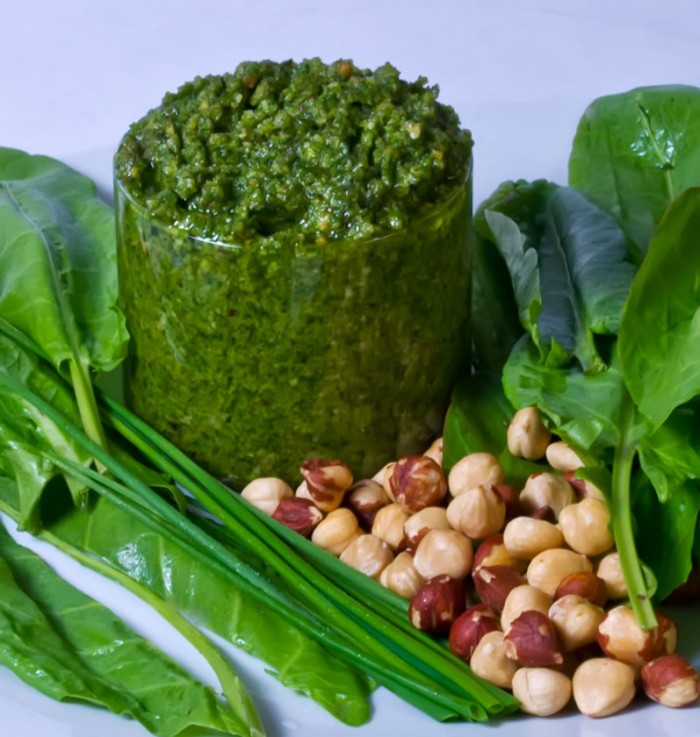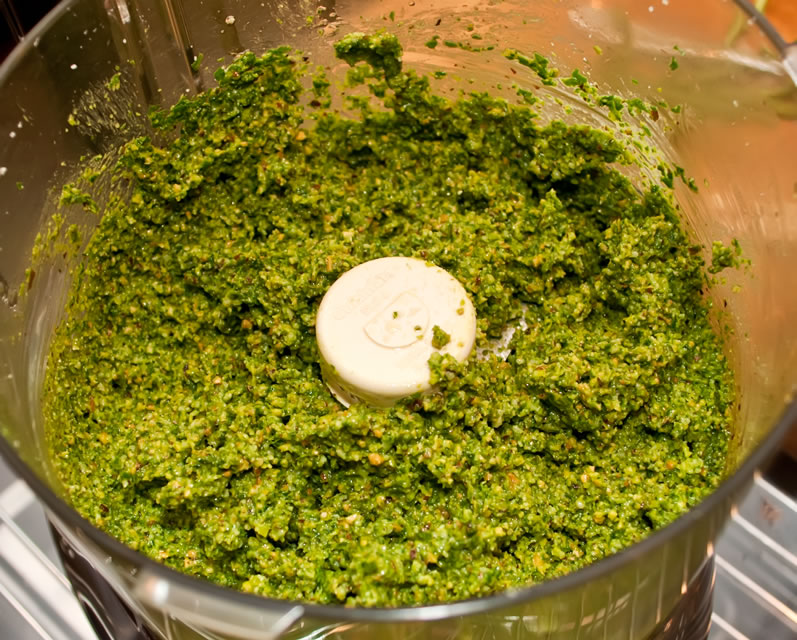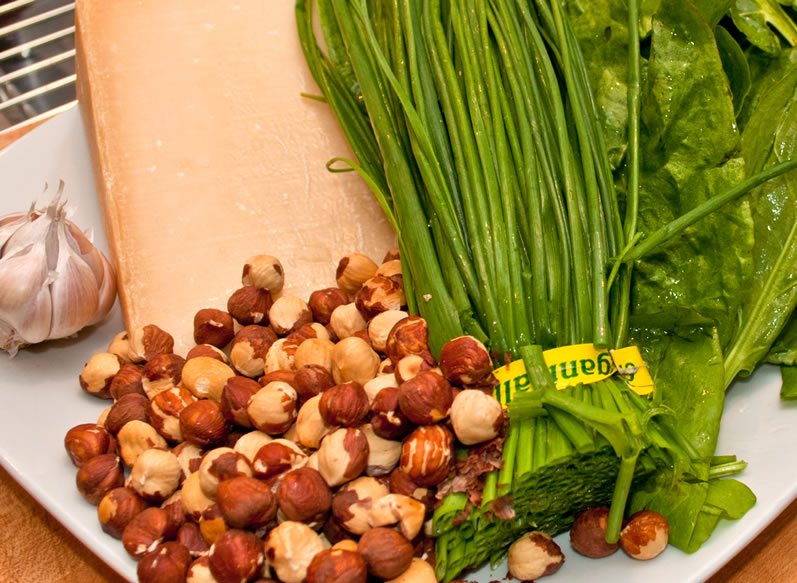Bright, spicy, lemony pesto, balanced with the earthy flavor of toasted hazelnuts.
 Pesto season is upon us once again. Hallelujah! Last year, I hit the test kitchen for several days and developed a balanced, sure-fire formula and five wonderful pestos: Rosemary Hazelnut Pesto, Cilantro Ginger Pesto, Herb Garden Pesto, Basil Arugula Pesto, and Basil Olive Pesto. I thought those recipes would suffice for years. Silly me.
Pesto season is upon us once again. Hallelujah! Last year, I hit the test kitchen for several days and developed a balanced, sure-fire formula and five wonderful pestos: Rosemary Hazelnut Pesto, Cilantro Ginger Pesto, Herb Garden Pesto, Basil Arugula Pesto, and Basil Olive Pesto. I thought those recipes would suffice for years. Silly me.
Because the first greens I spied at the opening of the Portland Farmers Market this spring were fresh sorrel and chives. I bought them both and planned to make soup. But then in the nick of time I remembered that sorrel doesn’t hold it’s gorgeous green color when heated. So why not make a creamy potato soup instead and swirl a Spicy Sorrel & Chive Pesto through it just before serving? Why not indeed.
But luckily there are so many other ways to use this pesto, because I made way more than was needed for the soup. You can spread it on sandwiches, quesadillas, hamburgers, pizza dough, or flatbread. Toss it with cooked pasta, spaetzle, or gnocchi. Drizzle it over grilled fish, an omelet, or steamed new potatoes. Mix it with mayonnaise, sour cream, or cream cheese for a tasty dip. Stir it into a quiche or savory cheesecake filling. The possibilities are nearly endless. Pesto is a cook’s best friend.
But before you run to the kitchen to whip up this pesto, let’s talk a moment about what oil to use. Cold-pressed, extra virgin olive oil is the traditional choice. That’s what I always used until a recent round of testing produced a particularly bitter pesto.
I tasted the oil, thinking perhaps it had gone rancid. Nope, fresh and fragrant, with no bitter after taste. So I tasted the sorrel. Again, fresh and very lemony, with no bitterness. Then I noshed on a few toasted hazelnuts. Delish. There was simply nothing in the pesto to account for the bitterness.
Perplexed, I searched the web to see if anyone had noticed this mysterious phenomenon. Bingo! The issue was explored in the March/April 2009 issue of Cook’s Illustrated Magazine.
As it turns out, extra-virgin olive oil contains bitter tasting polyphenols, which don’t usually assault your taste buds because they are coated with fatty acids. The fatty acids hold the polyphenols in check. Extreme agitation, as with a processor or blender, releases the full bitterness of the polyphenols.
The magazine claims that agitation is only a problem when mixing a mayonnaise or vinaigrette, because with pesto, the other ingredients buffer the reaction. In my recent tests, however, the polyphenols wreaked havoc with the pesto, lending a sharply bitter aftertaste. From now on, for pesto, I will use either a light olive oil or a flavorless vegetable oil. Lesson learned.
Spicy Sorrel Chive Pesto
This bright, lemony pesto is balanced with the earthy flavor of toasted hazelnuts. Fresh chives and garlic, plus a bit of spicy heat, takes the flavor combination over the top.
4 ounces (1 medium bunch) fresh sorrel leaves, stripped from the center ribs
2 ounces (small handful) fresh chives
2 garlic cloves, peeled
½ cup freshly grated parmesan or other dry grating cheese, such as pecorino romano, grana padano, dry asiago, or dry jack cheese
4 ounces (1 cup) toasted, skinned hazelnuts (or lightly toasted walnuts)
½-1 teaspoon crushed red pepper
½-1 cup light olive oil (or rapeseed or canola oil)
½ teaspoon fine sea salt, or to taste
- In a processor fitted with the steel knife, process sorrel, chives, garlic, cheese, hazelnuts, and red pepper until desired consistency (chunky, smooth, or in-between).
- Add ½ cup of oil, season to taste with salt, and pulse briefly to distribute. Add up to ½ up additional oil to achieve the desired consistency.
- Spoon the pesto into a container and cover with a tight fitting lid. Frig until needed. Pesto keeps, covered and chilled, for about two weeks.
Makes about 2 cups.
Cookin’ with Gas (inspiration from around the web)



Ooooh I cannot wait to get to the market, and make this! I love this time of year!
I cannot wait for my first pesto of the season – we are getting close! I haven’t found fresh basil yet, and I have been looking!
good point about the olive oil – we love oo so much in this house, and always have at least two bottles open. perhaps adding the oil after… ?
That is interesting about the olive oil, I haven’t noticed that problem (yet) but I’ll watch for it. I can’t blend garlic or onion in my high-speed blender without creating an extra-strong, unpleasant taste. My guess is it’s because the blender breaks down the cell walls.
Mary, yes, good point about the difference between chopping and blending garlic and onions. They are considerably more harsh when blended.
That is interesting about the olive oil, I haven’t noticed that problem (yet) but I’ll watch for it. I can’t blend garlic or onion in my high-speed blender without creating an extra-strong, unpleasant taste. My guess is because the blender breaks down the cell walls.
Hi Susan!!! Oh gosh, that pesto looks brilliant!!! I just had to “pop” in to say hi after reading about this recipe over at Oyster Culture. So glad I did. I haven’t been here in ages.
Love the tip about the oil. Will keep that in mind for sure.
Thank you so much for sharing this recipe. It sure is a keeper!!! Louise:)
Louise, so glad you stopped by and of course thank you for the lovely comments! Hopped on over to Oyster Culture (http://oysterfoodandculture.com/2011/07/sorrel-a-lucky-find-in-my-csa/) and added the site to my RSS feed. Thanks for the tip! Now don’t be a stranger, you hear?
Having received an abundance of sorrel and chives in my CSA box, I searched for a recipe to use them up, and happened upon this one. Thank you so much for the recipe! This is one of the most amazing things I’ve tasted in the past half-year, a perfect combination of flavors. I made it with sunflower oil. Yum!
Debra, thank you so much for sharing your results. I’m so glad you like this pesto as much as I do.
Oh my. You’ve got me excited over this one! I wonder what a watercress pesto would be like? I have a great source for that down here. Do you think I could sub in that for the sorrel? Lovely post! I loved the one about the 5 pestos too! yum yum.
Hey Dana! Watercress Pesto? Oh yeah! Watercess grows wild along the banks of Lake Washngton. I am always temtpted to pick it. Let us know how that turns out. I will try Radish Greens Pesto this weekend.
Watercress Pesto? Oh yeah! Watercess grows wild along the banks of Lake Washngton. I am always temtpted to pick it. Let us know how that turns out. I will try Radish Greens Pesto this weekend.
Huh, I had no idea about the extra virgin olive oil. Great tip!